Brain Development
Our formative nurture began at conception, with the prenatal environment in the womb. Nurture continued outside the womb, where our early experiences fostered brain development.
In your mother’s womb, your developing brain formed nerve cells at the explosive rate of nearly one-quarter million per minute. On the day you were born, you had most of the brain cells you would ever have. However, the wiring among these cells—your nervous system—was immature: After birth, these neural networks had a wild growth spurt branching and linking in patterns that would eventually enable you to walk, talk, and remember (FIGURE 11.1). This rapid development helps explain why infant brain size increases rapidly in the early days after birth (Holland et al., 2014).
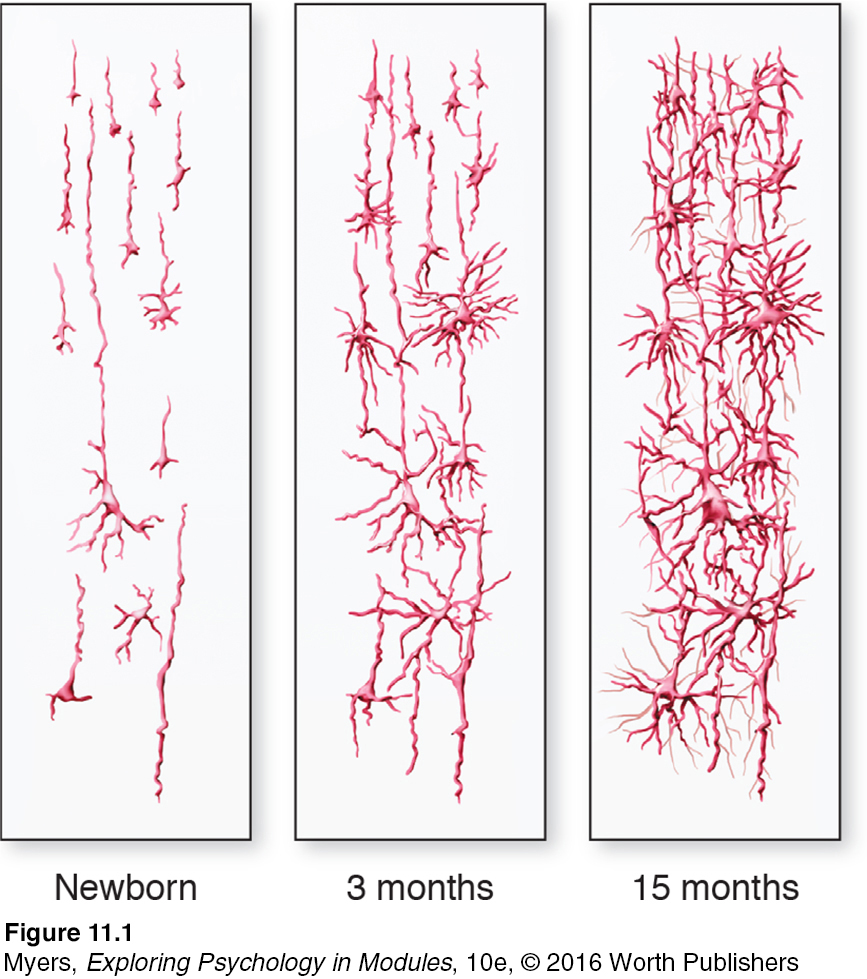
Figure 4.5: FIGURE 11.1 Drawings of human cerebral cortex sections In humans, the brain is immature at birth. As the child matures, the neural networks grow increasingly more complex.
From ages 3 to 6, the most rapid brain growth was in your frontal lobes, which enable rational planning. During those years, your brain required vast amounts of energy (Kuzawa et al., 2014). This energy-intensive process caused rapid progress in your ability to control your attention and behavior (Garon et al., 2008; Thompson-Schill et al., 2009). Frontal lobe development continues into adolescence and beyond.
The last cortical areas to develop are the association areas—those linked with thinking, memory, and language. As they develop, mental abilities surge (Chugani & Phelps, 1986; Thatcher et al., 1987). The neural pathways supporting agility, language, and self-control proliferate into puberty. Under the influence of adrenal hormones, tens of billions of synapses form and organize, while a use-it-or-lose-it pruning process shuts down unused links (Paus et al., 1999; Thompson et al., 2000).
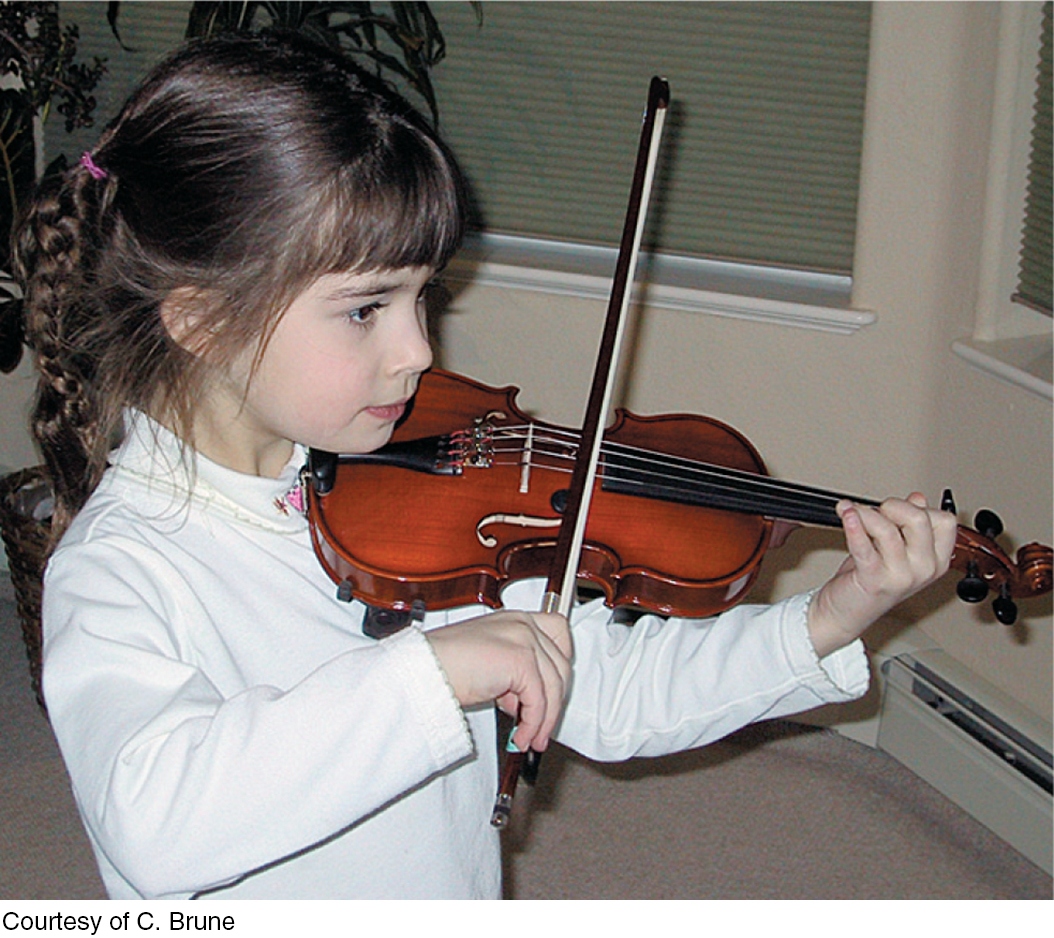
Stringing the circuits young String musicians who started playing before age 12 have larger and more complex neural circuits controlling the note-making left-hand fingers than do string musicians whose training started later (Elbert et al., 1995).
Courtesy of C. Brune
Your genes dictate your overall brain architecture, rather like the lines of a coloring book, but experience fills in the details (Kenrick et al., 2009). So how do early experiences leave their “fingerprints” in the brain? Mark Rosenzweig, David Krech, and their colleagues (1962) opened a window on that process when they raised some young rats in solitary confinement, and others in a communal playground that simulated a natural environment. When the researchers later analyzed the rats’ brains, those living in the enriched environment had usually developed a heavier and thicker brain cortex (FIGURE 11.2 below). So great are the effects that, shown brief video clips, you could tell from the rats’ activity and curiosity whether their environment had been impoverished or enriched (Renner & Renner, 1993). After 60 days in the enriched environment, the rats’ brain weights increased 7 to 10 percent and the number of synapses mushroomed by about 20 percent (Kolb & Whishaw, 1998).

Figure 4.6: FIGURE 11.2 Experience affects brain development Mark Rosenzweig, David Krech, and their colleagues (1962) raised rats either alone in an environment without playthings, or with other rats in an environment enriched with playthings changed daily. In 14 of 16 repetitions of this basic experiment, rats in the enriched environment developed significantly more cerebral cortex (relative to the rest of the brain’s tissue) than did those in the impoverished environment.
Such results have motivated improvements in environments for laboratory, farm, and zoo animals—and for children in institutions. Stimulation by touch or massage also benefits infant rats and premature babies (Field et al., 2007; Sarro et al., 2014). “Handled” infants of both species develop faster neurologically and gain weight more rapidly. Preemies who have had skin-to-skin contact with their mothers sleep better, experience less stress, and show better cognitive development 10 years later (Feldman et al., 2014).
Page 128
Nature and nurture interact to sculpt our synapses. Brain maturation provides us with an abundance of neural connections. Experiences—sights and smells, touches and tastes, music and movement—activate and strengthen some neural pathways while others weaken from disuse. Like forest pathways, popular tracks are broadened and less-traveled ones gradually disappear. The result by puberty is a massive loss of unemployed connections.
critical period an optimal period early in the life of an organism when exposure to certain stimuli or experiences produces normal development.
Here at the juncture of nurture and nature is the biological reality of early childhood learning. During early childhood—while excess connections are still on call—youngsters can most easily master such skills as the grammar and accent of another language. We seem to have a critical period for some skills. Lacking any exposure to spoken, written, or signed language before adolescence, a person will never master any language. Likewise, lacking visual experience during the early years, a person whose vision is restored by cataract removal will never achieve normal perceptions (Gregory, 1978; Wiesel, 1982). Without that early visual stimulation, the brain cells normally assigned to vision will die during the pruning process or be diverted to other uses. The maturing brain’s rule: Use it or lose it.
“Genes and experiences are just two ways of doing the same thing—wiring synapses.”
Joseph LeDoux,
The Synaptic Self, 2002
Although normal stimulation during the early years is critical, the brain’s development does not end with childhood. Thanks to the brain’s amazing plasticity, our neural tissue is ever changing and reorganizing in response to new experiences. New neurons also are born. If a monkey pushes a lever with the same finger many times a day, brain tissue controlling that finger changes to reflect the experience (FIGURE 11.3). Human brains work similarly. Whether learning to keyboard, skateboard, or navigate London’s streets, we perform with increasing skill as our brain incorporates the learning (Ambrose, 2010; Maguire et al., 2000).
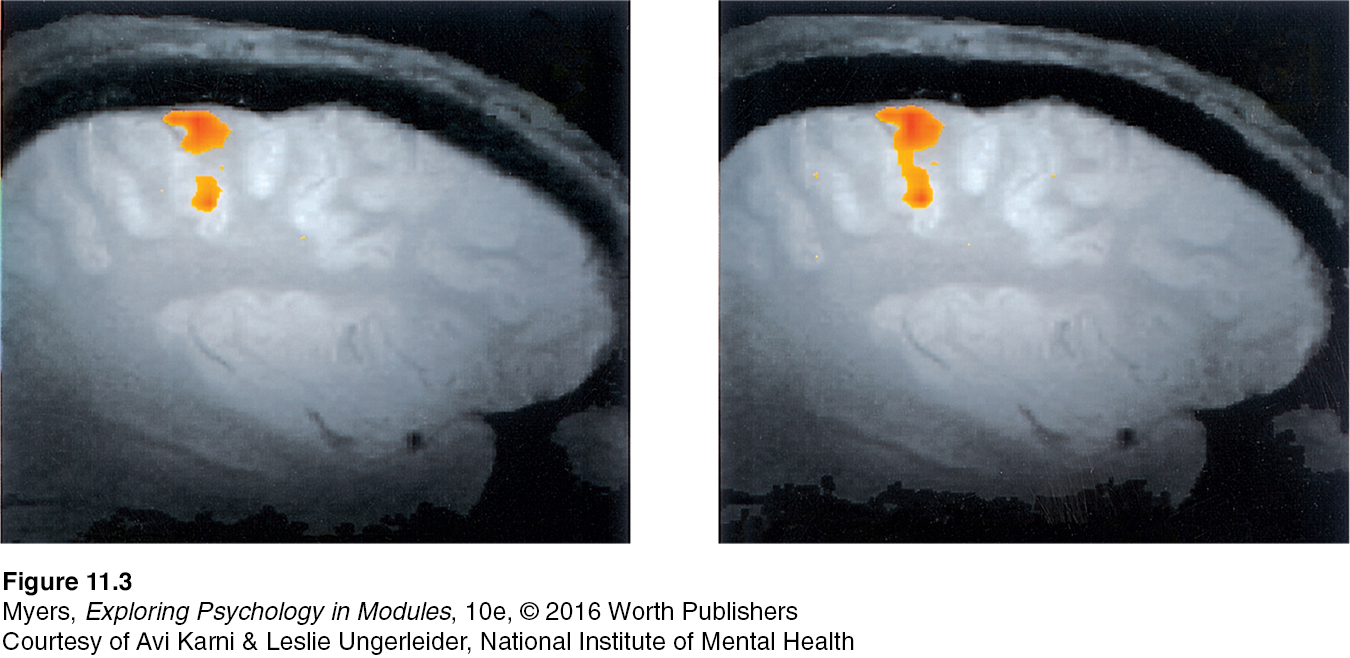
Figure 4.7: FIGURE 11.3 A trained brain A well-learned finger-tapping task activates more motor cortex neurons (orange area, right) than were active in this monkey’s brain before training (left). (From Karni et al., 1998.)
Courtesy of Avi Karni & Leslie Ungerleider, National Institute of Mental Health
Motor Development
The developing brain enables physical coordination. As an infant exercises its maturing muscles and nervous system, skills emerge. With occasional exceptions, the sequence of physical (motor) development is universal. Babies roll over before they sit unsupported, and they usually crawl on all fours before they walk. These behaviors reflect not imitation but a maturing nervous system; blind children, too, crawl before they walk.
In the United States, 25 percent of all babies walk by 11 months of age, 50 percent within a week after their first birthday, and 90 percent by age 15 months (Frankenburg et al., 1992). In some regions of Africa, the Caribbean, and India, caregivers frequently massage and exercise babies, which can accelerate the process of learning to walk (Karasik et al., 2010). The recommended infant back to sleep position (putting babies to sleep on their backs to reduce the risk of a smothering crib death) has been associated with somewhat later crawling but not with later walking (Davis et al., 1998; Lipsitt, 2003).
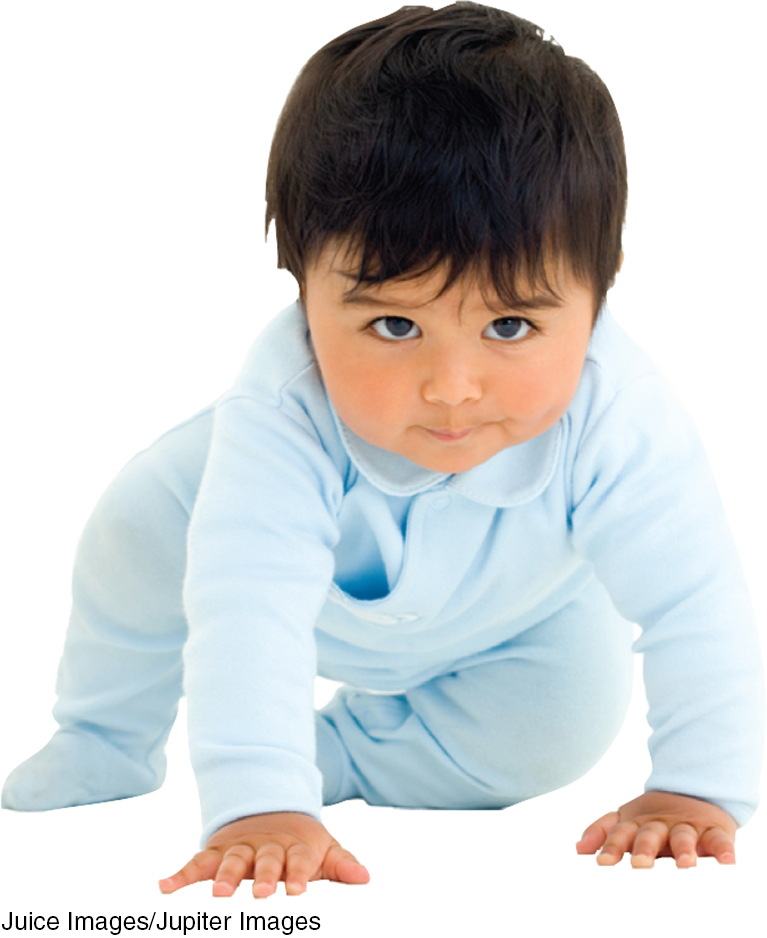
Physical development Sit, crawl, walk, run—the sequence of these motor development milestones is the same the world around, though babies reach them at varying ages.
Juice Images/JupiterImages
In the eight years following the 1994 launch of a U.S. Back to Sleep educational campaign, the number of infants sleeping on their stomach dropped from 70 to 11 percent—and sudden unexpected infant deaths fell significantly (Braiker, 2005).
Page 129
Genes guide motor development. Identical twins typically begin walking on nearly the same day (Wilson, 1979). Maturation—including the rapid development of the cerebellum at the back of the brain—creates our readiness to learn walking at about age 1. The same is true for other physical skills, including bowel and bladder control. Before necessary muscular and neural maturation, neither pleading nor punishment will produce successful toilet training.
Brain Maturation and Infant Memory
Can you recall your first day of preschool or your third birthday party? Studies have confirmed that our average age of earliest conscious memory is 3.5 years (Bauer, 2002, 2007). But as children mature, by age 7 or so, infantile amnesia wanes, and they become increasingly capable of remembering experiences, even for a year or more (Bauer & Larkina, 2014; Morris et al., 2010). Mice and monkeys also forget their early life, as rapid neuron growth disrupts the circuits that stored old memories (Akers et al., 2014). The brain areas underlying memory, such as the hippocampus and frontal lobes, continue to mature into adolescence (Bauer, 2007).
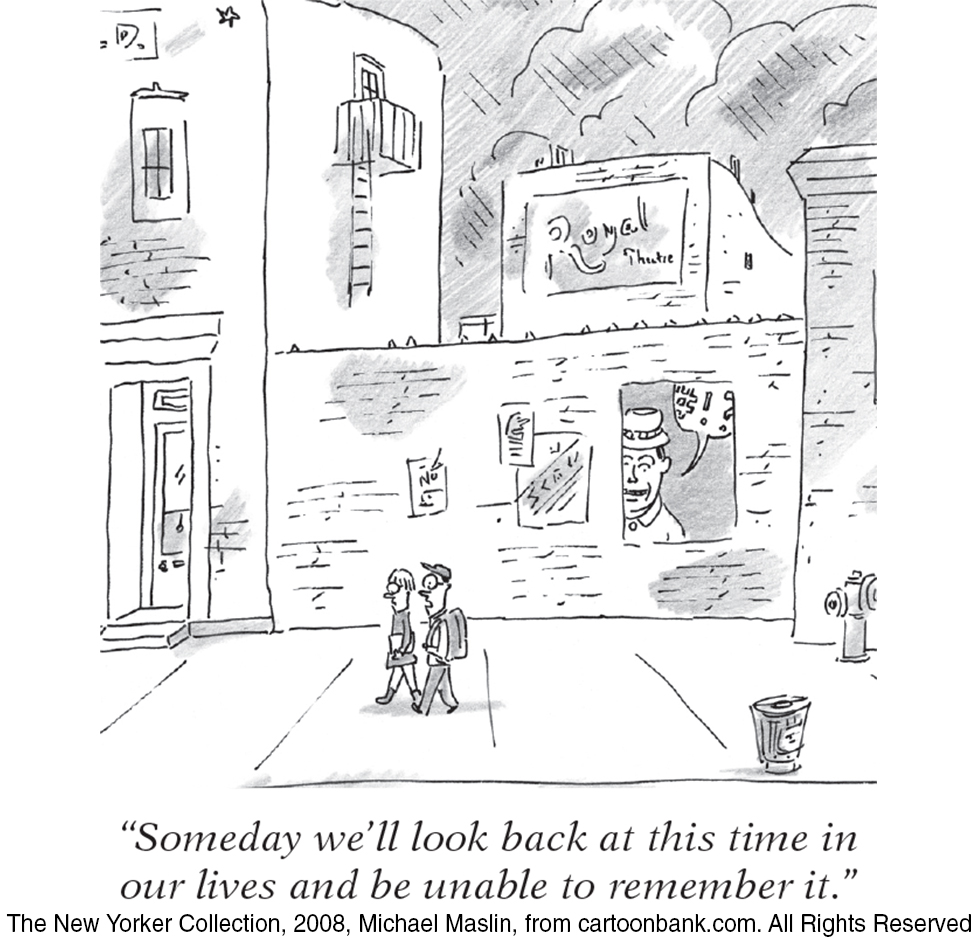
The New Yorker Collection, 2008, Michael Maslin, from
cartoonbank.com. All Rights Reserved
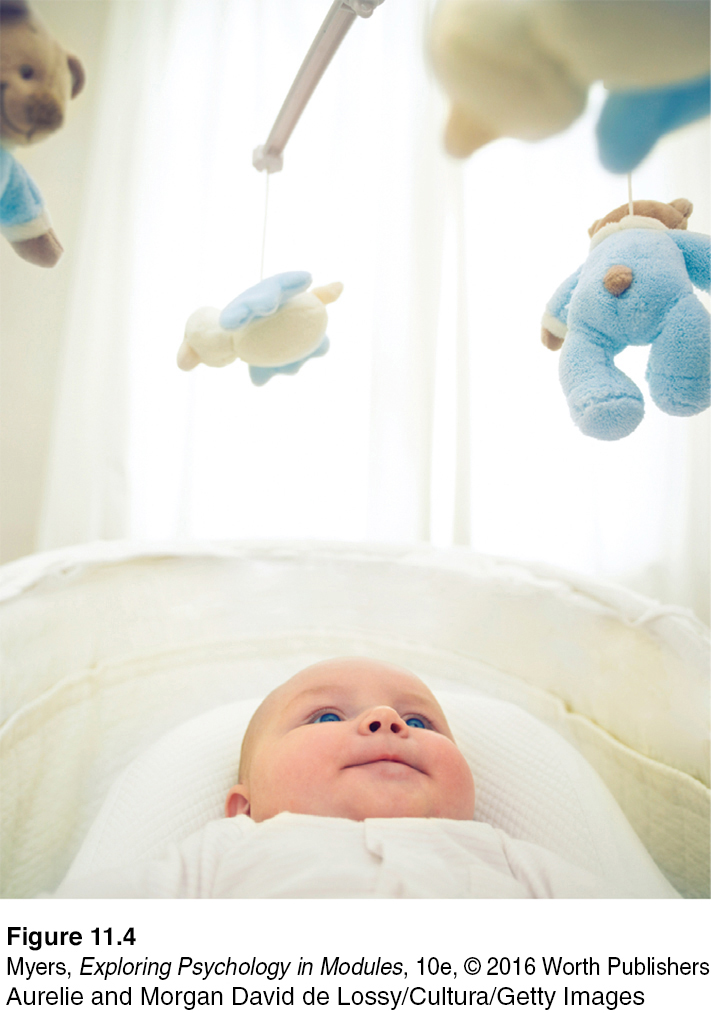
Figure 4.8: FIGURE 11.4 Infant at work Babies only 3 months old can learn that kicking moves a mobile, and they can retain that learning for a month (Rovee-Collier, 1989, 1997).
Aurelie and Morgan David de Lossy/Cultura/Getty Images
Apart from constructed memories based on photos and family stories, we consciously recall little from our early years, yet our brain was processing and storing information. While finishing her doctoral work in psychology, Carolyn Rovee-Collier observed nonverbal infant memory in action. Her colicky 2-month-old, Benjamin, could be calmed by moving a crib mobile. Weary of hitting the mobile, she strung a cloth ribbon connecting the mobile to Benjamin’s foot. Soon, he was kicking his foot to move the mobile. Thinking about her unintended home experiment, Rovee-Collier realized that, contrary to popular opinion in the 1960s, babies can learn. To know for sure that her son wasn’t just a whiz kid, she repeated the experiment with other infants (Rovee-Collier, 1989, 1999). Sure enough, they, too, soon kicked more when hitched to a mobile, both on the day of the experiment and the day after. If, however, she hitched them to a different mobile the next day, the infants showed no learning, indicating that they remembered the original mobile and recognized the difference. Moreover, when tethered to the familiar mobile a month later, they remembered the association and again began kicking (FIGURE 11.4).
Traces of forgotten childhood languages may also persist. One study tested English-speaking British adults who had no conscious memory of the Hindi or Zulu they had spoken as children. Yet, up to age 40, they could relearn subtle sound contrasts in these languages that other people could not learn (Bowers et al., 2009). What the conscious mind does not know and cannot express in words, the nervous system and our two-track mind somehow remember.






